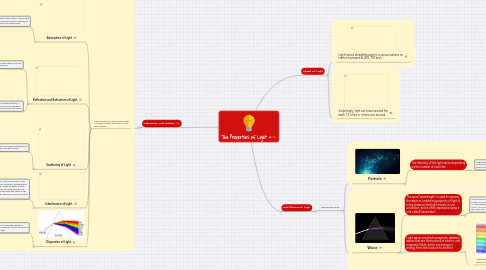
1. Interaction with Matter
1.1. Light behaves in a variety of ways when it comes in contact with water, air, and other matters.
1.1.1. Absorption of Light
1.1.1.1. When light strikes matter, a part of that light is absorbed into the matter and is transformed into heat energy.
1.1.1.1.1. ex. How Tomatoes Appear Red
1.1.2. Reflection and Refraction of Light
1.1.2.1. If the surface of the material is smooth, the light bounces back.
1.1.2.1.1. ex. Image of the River Reflecting the Mountain
1.1.2.2. Light refracts at the boundary between 2 different media. Refraction occurs because light travels at different speed in both media.
1.1.2.2.1. ex. Bending of Straw in Water
1.1.3. Scattering of Light
1.1.3.1. If the surface is irregular having pits and protrusions, the light scatters.
1.1.3.1.1. ex. Sky at Sunset
1.1.4. Interference of Light
1.1.4.1. Light moves in various directions so the light waves are constantly striking against each another. When the peaks of these waves overlap, the peaks become even larger. When the peaks and valleys of the waves collide, the waves cancel each other out.
1.1.4.1.1. ex. Mysterious Colors of Blowing Soap Bubbles
1.1.5. Dispersion of Light
1.1.5.1. Using a prism,the white light beam separates, allowing us to see the various colors of light.
1.1.5.1.1. ex. Rainbow in the Sky after the Rain
2. Speed of Light
2.1. Light travels striaghtforward in a vacuum where no matter is present at 299, 792 km/s.
2.2. Surprisingly, light can travel around the earth 7.5 times in a mere one second.
3. Dual Nature of Light
3.1. Light has dual nature:
3.1.1. Particle
3.1.1.1. The intensity of the light varies depending on the number of particles.
3.1.1.1.1. Bright light has many particles while dark light has fewer particles. These particles of light are called “photons”.
3.1.2. Wave
3.1.2.1. The word “wavelength” is used to express the wave or undulating property of light. It is the distance that light travels in one oscillation, and is often expressed using a unit called "nanometer".
3.1.2.1.1. One nanometer is equal to one billionth of a meter. Our eyes can only see light that is of a wavelength between approximately 400 to 700 nanometers. This range is called the visible light.
3.1.2.2. Light waves are electromagnetic radiation waves that are fluctuations of electric and magnetic fields, which can transport energy from one location to another.
3.1.2.2.1. Visible light is not inherently different from the other parts of the electromagnetic spectrum with the exception that the human eye can detect visible waves.
